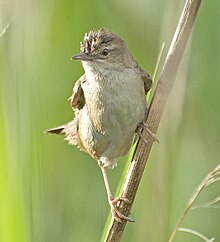Locustella luscinoides
| Savi's warbler | |
|---|---|
 |
|
| Scientific classification | |
| Kingdom: | Animalia |
| Phylum: | Chordata |
| Class: | Aves |
| Order: | Passeriformes |
| Family: | Locustellidae |
| Genus: | Locustella |
| Species: | L. luscinoides |
| Binomial name | |
|
Locustella luscinioides (Savi, 1824) |
|
The Savi's warbler (Locustella luscinioides) is a species of Old World warbler in the grass warbler genus Locustella. It breeds in southern Europe and temperate western Asia. It is migratory, wintering in northern and sub-Saharan Africa.
This small passerine bird is found in reed beds, usually with some bushes. Three to six eggs are laid in a nest in reeds. The adult has an unstreaked grey-brown back, whitish grey underparts and a lack of throat streaks, which is a distinction from the river warbler. The sexes are identical, as with most warblers, but young birds are yellower below. Like most warblers, it is insectivorous. This is not a shy species, but can be difficult to see in the reeds except sometimes when singing.
The ![]() "song" is a monotonous mechanical insect-like reeling, often given at dusk. It is similar to the song of other species in the group, but is generally faster and deeper and bears a strong resemblance to that of Roesel's bush-cricket.
"song" is a monotonous mechanical insect-like reeling, often given at dusk. It is similar to the song of other species in the group, but is generally faster and deeper and bears a strong resemblance to that of Roesel's bush-cricket.
The common name of this bird recognises the Italian ornithologist Paolo Savi, the author of "Ornitologia Toscana" (1827–1831) and "Ornitologia Italiana" (1873–1876). In 1821, Savi was given specimens of an unstreaked, dark, rufous-brown warbler which was new to science. He published a full description of the bird in 1824, and it became known by the common name of Savi's warbler. The genus name Locustella is from Latin and is a diminutive of locusta, "grasshopper". This refers to the song of the common grasshopper warbler and some others in this genus. The specific luscinioides is from Latin luscinia," nightingale", and Ancient Greek -oides, "resembling".
...
Wikipedia

